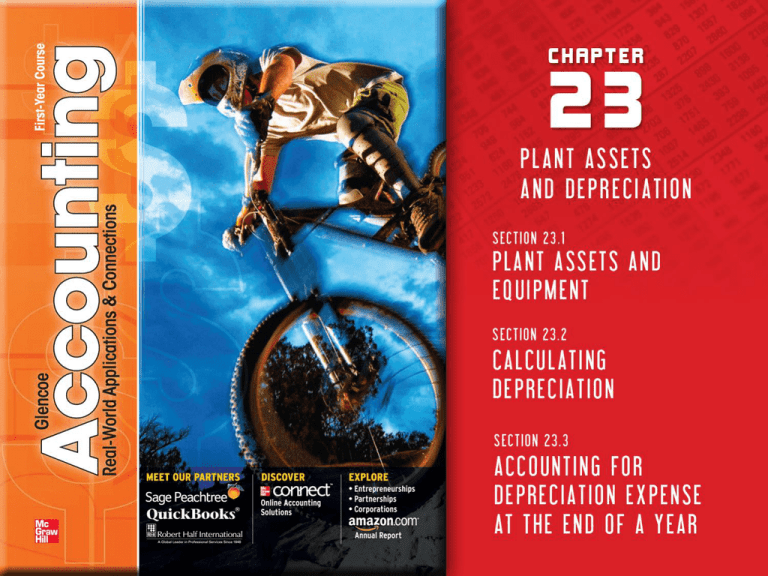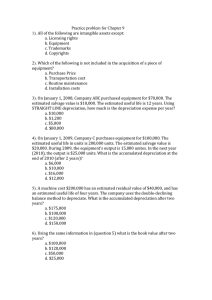
A business uses plant assets for more
than one accounting period, so it
spreads the cost of these assets over
a number of years. A business must
also calculate depreciation of certain
plant assets.
Glencoe Accounting
Copyright © by The McGraw-Hill Companies, Inc. All rights reserved.
Identify plant assets.
Explain the need to depreciate plant assets.
Calculate annual depreciation of plant assets.
Calculate partial-year depreciation of plant assets.
Determine the book value of a plant asset.
Record depreciation of plant assets.
Prepare depreciation schedules.
Glencoe Accounting
Copyright © by The McGraw-Hill Companies, Inc. All rights reserved.
Plant Assets
and Equipment
Section 23.1
Key Terms
plant assets
depreciation
disposal value
straight-line depreciation
Glencoe Accounting
Copyright © by The McGraw-Hill Companies, Inc. All rights reserved.
Current and Plant Assets
Plant Assets
and Equipment
Section 23.1
Land
Office
Equipment
Buildings
Examples of
Plant Assets
Store
Equipment
Glencoe Accounting
plant assets
Long-lived assets
that are used in the
production or sale of
other assets or services
over several
accounting periods.
Delivery
Equipment
Copyright © by The McGraw-Hill Companies, Inc. All rights reserved.
Estimating Depreciation of a
Plant Asset
Section 23.1
Plant Assets
and Equipment
Cost
Factors Used
to Calculate
Depreciation
Estimated Useful Life
Estimated Disposal Value
Depreciation Method
depreciation
Allocating a plant asset’s cost over its useful life.
Glencoe Accounting
Copyright © by The McGraw-Hill Companies, Inc. All rights reserved.
Estimating Depreciation of a
Plant Asset
Section 23.1
Plant Assets
and Equipment
The cost of a plant asset is equal to the purchase price plus
sales taxes, delivery charges, and installation charges.
Glencoe Accounting
Copyright © by The McGraw-Hill Companies, Inc. All rights reserved.
Estimating Depreciation of a
Plant Asset
Section 23.1
Plant Assets
and Equipment
Estimated useful life can be calculated using
past experiences.
Glencoe Accounting
Copyright © by The McGraw-Hill Companies, Inc. All rights reserved.
Estimating Depreciation of a
Plant Asset
Section 23.1
Plant Assets
and Equipment
The IRS publishes guidelines on disposal values.
disposal value
The estimated value of a plant asset at its
replacement time; also called salvage value.
Glencoe Accounting
Copyright © by The McGraw-Hill Companies, Inc. All rights reserved.
Estimating Depreciation of a
Plant Asset
Section 23.1
Plant Assets
and Equipment
Depreciation
Methods
Straight-Line
Depreciation Method
Units-of-Production
Method
straight-line depreciation
A method that equally
distributes the depreciation
expense over an asset’s
estimated useful life.
Accelerated Depreciation
Method
Glencoe Accounting
Copyright © by The McGraw-Hill Companies, Inc. All rights reserved.
Estimating Depreciation of a
Plant Asset
Section 23.1
Plant Assets
and Equipment
Federal Income Tax Laws for Depreciating Assets
The Accelerated Cost
Recovery System (ACRS)
Allows a business to recognize
depreciation over a shorter period
of time and does not consider
disposal value.
Glencoe Accounting
Modified Accelerated Cost
Recovery System (MARCS)
Used for tax accounting only.
Copyright © by The McGraw-Hill Companies, Inc. All rights reserved.
Section 23.2
Calculating Depreciation
Key Terms
accumulated depreciation
book value
Glencoe Accounting
Copyright © by The McGraw-Hill Companies, Inc. All rights reserved.
Calculating Depreciation
Section 23.2
Calculating Depreciation
Calculate Depreciation
Glencoe Accounting
Copyright © by The McGraw-Hill Companies, Inc. All rights reserved.
Calculating Depreciation
Section 23.2
Calculating Depreciation
Straight-Line Depreciation
Glencoe Accounting
Copyright © by The McGraw-Hill Companies, Inc. All rights reserved.
Calculating Depreciation
Section 23.2
Calculating Depreciation
Straight-Line Depreciation
Glencoe Accounting
Copyright © by The McGraw-Hill Companies, Inc. All rights reserved.
Calculating Depreciation
Section 23.2
Calculating Depreciation
Declining-Balance Depreciation
The annual depreciation expense is the asset’s book
value multiplied by the declining-balance rate.
This rate can vary but it is usually double the
straight line rate.
Glencoe Accounting
Copyright © by The McGraw-Hill Companies, Inc. All rights reserved.
Plant Asset Records
Section 23.2
Calculating Depreciation
Information in the Plant Asset Record
Glencoe Accounting
1
Date of Purchase
2
Original Cost
3
Estimated Useful Life
4
Annual Depreciation
5
Accumulated Depreciation
6
Book Value at the End of Each Year
Copyright © by The McGraw-Hill Companies, Inc. All rights reserved.
Plant Asset Records
Section 23.2
Calculating Depreciation
See page 678
accumulated depreciation
The total amount of depreciation for a plant asset that
has been recorded up to a specific point in time.
Glencoe Accounting
Copyright © by The McGraw-Hill Companies, Inc. All rights reserved.
Plant Asset Records
Section 23.2
Calculating Depreciation
See page 678
book value
The original cost of a plant asset minus
accumulated depreciation.
Glencoe Accounting
Copyright © by The McGraw-Hill Companies, Inc. All rights reserved.
Adjusting for
Depreciation Expense
Section 23.3
Accounting for a
Depreciation Expense
at the End of a Year
See page 680
Information to make depreciation adjustments comes from
the plant asset records. Each type of asset has its own
depreciation expense summary.
Glencoe Accounting
Copyright © by The McGraw-Hill Companies, Inc. All rights reserved.
Adjusting for
Depreciation Expense
Section 23.3
Accounting for a
Depreciation Expense
at the End of a Year
Depreciation
Expense
Two accounts affected
by the adjustment for
depreciation:
Glencoe Accounting
Accumulated
Depreciation
Copyright © by The McGraw-Hill Companies, Inc. All rights reserved.
Adjusting for
Depreciation Expense
Section 23.3
Accounting for a
Depreciation Expense
at the End of a Year
The debit and credit rules followed by the Accumulated
Depreciation account are opposite those for an asset account.
Glencoe Accounting
Copyright © by The McGraw-Hill Companies, Inc. All rights reserved.
Adjusting for
Depreciation Expense
Section 23.3
Accounting for a
Depreciation Expense
at the End of a Year
During the year,
Depreciation Expense has
a zero balance because
the adjustment for
depreciation is recorded
at the end of the period.
Glencoe Accounting
The account is closed to
Income Summary at the
end of the year.
Copyright © by The McGraw-Hill Companies, Inc. All rights reserved.
Adjusting for
Depreciation Expense
Section 23.3
Accounting for a
Depreciation Expense
at the End of a Year
Business Transaction
On December 31 the accounting clerk for The Starting Line records the
depreciation for the delivery truck.
See page 681–682
Glencoe Accounting
Copyright © by The McGraw-Hill Companies, Inc. All rights reserved.
Adjusting for
Depreciation Expense
Section 23.3
Accounting for a
Depreciation Expense
at the End of a Year
Work Sheet with Depreciation Adjustments
See page 682
Glencoe Accounting
Copyright © by The McGraw-Hill Companies, Inc. All rights reserved.
Adjusting for
Depreciation Expense
Section 23.3
Accounting for a
Depreciation Expense
at the End of a Year
The depreciation expense accounts are reported on the
income statement.
See page 684
Glencoe Accounting
Copyright © by The McGraw-Hill Companies, Inc. All rights reserved.
Adjusting for
Depreciation Expense
Section 23.3
Accounting for a
Depreciation Expense
at the End of a Year
The plant asset and related accumulated depreciation accounts
appear in the assets section of the balance sheet.
See page 684
Glencoe Accounting
Copyright © by The McGraw-Hill Companies, Inc. All rights reserved.
Adjusting and Closing Entries
for Depreciation Expense
Section 23.3
Accounting for a
Depreciation Expense
at the End of a Year
Adjustment
Record the December 31 adjusting journal entries for depreciation.
See page 685
Glencoe Accounting
Copyright © by The McGraw-Hill Companies, Inc. All rights reserved.
Adjusting and Closing Entries
for Depreciation Expense
Section 23.3
Accounting for a
Depreciation Expense
at the End of a Year
Adjustment
Record the December 31 adjusting journal entries for depreciation.
See page 685
Glencoe Accounting
Copyright © by The McGraw-Hill Companies, Inc. All rights reserved.
Adjusting and Closing Entries
for Depreciation Expense
Section 23.3
Accounting for a
Depreciation Expense
at the End of a Year
Closing
Second Closing Entry—Depreciation accounts only.
See page 686
Glencoe Accounting
Copyright © by The McGraw-Hill Companies, Inc. All rights reserved.
Adjusting and Closing Entries
for Depreciation Expense
Section 23.3
Accounting for a
Depreciation Expense
at the End of a Year
Closing
Second Closing Entry—Depreciation accounts only.
See page 686
Glencoe Accounting
Copyright © by The McGraw-Hill Companies, Inc. All rights reserved.
Question 1
On March 1 Lakeview Landscape purchased a new dump truck for $45,000. The
truck will have a useful life of 10 years and a disposal value of $7,500.
(a) Using straight-line depreciation, calculate the yearly depreciation of the truck.
(b) How much could you depreciate in Year 1?
a) Step 1: Subtract the disposal value from the cost of the truck:
$45,000 - $7,500 = $37,500 to be depreciated
Step 2: Divide the amount to be depreciated by the useful life of the
asset: $37,500 ÷ 10 = $3,750 per year
b) Calculate depreciation in Year 1 (for 10 months, March 1 to December
31): $3,750 x 10/12 = $3,125
Glencoe Accounting
Copyright © by The McGraw-Hill Companies, Inc. All rights reserved.
Question 2
Why would a corporation choose to use an accelerated depreciation system such
as declining-balance depreciation instead of straight-line depreciation?
An accelerated depreciation schedule allows the corporation to take a
higher expense early in the life of the asset. Since money today is more
desirable than money one year from now, it allows the corporation to realize
tax benefits early.
Glencoe Accounting
Copyright © by The McGraw-Hill Companies, Inc. All rights reserved.
End of






